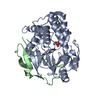[English] 日本語
 Yorodumi
Yorodumi- PDB-8a8f: Crystal structure of Glc7 phosphatase in complex with the regulat... -
+ Open data
Open data
- Basic information
Basic information
| Entry | Database: PDB / ID: 8a8f | |||||||||
|---|---|---|---|---|---|---|---|---|---|---|
| Title | Crystal structure of Glc7 phosphatase in complex with the regulatory region of Ref2 | |||||||||
 Components Components |
| |||||||||
 Keywords Keywords | GENE REGULATION / Ser/Thr phosphatase / regulatory subunit / RNA / transcription termination | |||||||||
| Function / homology |  Function and homology information Function and homology informationregulation of cell budding / regulation of protein localization to cell division site involved in cytokinesis / cellular bud neck septin collar / mating projection base / positive regulation of mitotic actomyosin contractile ring assembly / regulation of cellular response to glucose starvation / Resolution of Sister Chromatid Cohesion / positive regulation of clathrin-dependent endocytosis / termination of RNA polymerase II transcription, poly(A)-coupled / sno(s)RNA 3'-end processing ...regulation of cell budding / regulation of protein localization to cell division site involved in cytokinesis / cellular bud neck septin collar / mating projection base / positive regulation of mitotic actomyosin contractile ring assembly / regulation of cellular response to glucose starvation / Resolution of Sister Chromatid Cohesion / positive regulation of clathrin-dependent endocytosis / termination of RNA polymerase II transcription, poly(A)-coupled / sno(s)RNA 3'-end processing / regulation of glycogen biosynthetic process / chitin biosynthetic process / cellular bud site selection / ascospore formation / regulation of glycogen metabolic process / positive regulation of exit from mitosis / protein phosphatase type 1 complex / incipient cellular bud site / intracellular monoatomic ion homeostasis / mRNA cleavage and polyadenylation specificity factor complex / negative regulation of actin filament polymerization / cellular bud neck / DNA replication checkpoint signaling / protein localization to kinetochore / spindle pole body / mRNA 3'-end processing / glycogen metabolic process / cell division site / mitotic spindle assembly checkpoint signaling / protein-serine/threonine phosphatase / protein serine/threonine phosphatase activity / replication fork processing / response to unfolded protein / chromosome organization / regulation of mitotic cell cycle / telomere maintenance / DNA damage checkpoint signaling / meiotic cell cycle / chromosome segregation / kinetochore / mRNA processing / regulation of cell shape / response to heat / regulation of cell cycle / chromatin binding / nucleolus / positive regulation of transcription by RNA polymerase II / RNA binding / metal ion binding / nucleus / cytosol / cytoplasm Similarity search - Function | |||||||||
| Biological species |  | |||||||||
| Method |  X-RAY DIFFRACTION / X-RAY DIFFRACTION /  SYNCHROTRON / SYNCHROTRON /  MOLECULAR REPLACEMENT / Resolution: 1.85 Å MOLECULAR REPLACEMENT / Resolution: 1.85 Å | |||||||||
 Authors Authors | Carminati, M. / Manav, C.M. / Bellini, D. / Passmore, L.A. | |||||||||
| Funding support | European Union, 2items
| |||||||||
 Citation Citation |  Journal: Mol Cell / Year: 2023 Journal: Mol Cell / Year: 2023Title: A direct interaction between CPF and RNA Pol II links RNA 3' end processing to transcription. Authors: Manuel Carminati / Juan B Rodríguez-Molina / M Cemre Manav / Dom Bellini / Lori A Passmore /  Abstract: Transcription termination by RNA polymerase II (RNA Pol II) is linked to RNA 3' end processing by the cleavage and polyadenylation factor (CPF or CPSF). CPF contains endonuclease, poly(A) polymerase, ...Transcription termination by RNA polymerase II (RNA Pol II) is linked to RNA 3' end processing by the cleavage and polyadenylation factor (CPF or CPSF). CPF contains endonuclease, poly(A) polymerase, and protein phosphatase activities, which cleave and polyadenylate pre-mRNAs and dephosphorylate RNA Pol II to control transcription. Exactly how the RNA 3' end processing machinery is coupled to transcription remains unclear. Here, we combine in vitro reconstitution, structural studies, and genome-wide analyses to show that yeast CPF physically and functionally interacts with RNA Pol II. Surprisingly, CPF-mediated dephosphorylation promotes the formation of an RNA Pol II stalk-to-stalk homodimer in vitro. This dimer is compatible with transcription but not with the binding of transcription elongation factors. Disruption of the dimerization interface in cells causes transcription defects, including altered RNA Pol II abundance on protein-coding genes, tRNA genes, and intergenic regions. We hypothesize that RNA Pol II dimerization may provide a mechanistic basis for the allosteric model of transcription termination. | |||||||||
| History |
|
- Structure visualization
Structure visualization
| Structure viewer | Molecule:  Molmil Molmil Jmol/JSmol Jmol/JSmol |
|---|
- Downloads & links
Downloads & links
- Download
Download
| PDBx/mmCIF format |  8a8f.cif.gz 8a8f.cif.gz | 90.6 KB | Display |  PDBx/mmCIF format PDBx/mmCIF format |
|---|---|---|---|---|
| PDB format |  pdb8a8f.ent.gz pdb8a8f.ent.gz | 66.2 KB | Display |  PDB format PDB format |
| PDBx/mmJSON format |  8a8f.json.gz 8a8f.json.gz | Tree view |  PDBx/mmJSON format PDBx/mmJSON format | |
| Others |  Other downloads Other downloads |
-Validation report
| Summary document |  8a8f_validation.pdf.gz 8a8f_validation.pdf.gz | 457.7 KB | Display |  wwPDB validaton report wwPDB validaton report |
|---|---|---|---|---|
| Full document |  8a8f_full_validation.pdf.gz 8a8f_full_validation.pdf.gz | 460.5 KB | Display | |
| Data in XML |  8a8f_validation.xml.gz 8a8f_validation.xml.gz | 16.1 KB | Display | |
| Data in CIF |  8a8f_validation.cif.gz 8a8f_validation.cif.gz | 22.5 KB | Display | |
| Arichive directory |  https://data.pdbj.org/pub/pdb/validation_reports/a8/8a8f https://data.pdbj.org/pub/pdb/validation_reports/a8/8a8f ftp://data.pdbj.org/pub/pdb/validation_reports/a8/8a8f ftp://data.pdbj.org/pub/pdb/validation_reports/a8/8a8f | HTTPS FTP |
-Related structure data
| Related structure data |  7qwjS S: Starting model for refinement C: citing same article ( |
|---|---|
| Similar structure data | Similarity search - Function & homology  F&H Search F&H Search |
- Links
Links
- Assembly
Assembly
| Deposited unit | 
| ||||||||
|---|---|---|---|---|---|---|---|---|---|
| 1 |
| ||||||||
| Unit cell |
|
- Components
Components
| #1: Protein | Mass: 36036.344 Da / Num. of mol.: 1 Source method: isolated from a genetically manipulated source Details: The Glc7 C-terminus is covalently linked to chain B (Ref2 348-405) Source: (gene. exp.)  Strain: ATCC 204508 / S288c / Gene: GLC7, CID1, DIS2, YER133W / Plasmid: pET24a Production host:  References: UniProt: P32598, protein-serine/threonine phosphatase | ||||||
|---|---|---|---|---|---|---|---|
| #2: Protein | Mass: 8500.543 Da / Num. of mol.: 1 Source method: isolated from a genetically manipulated source Details: To trap the Glc7 substrate in the active site, two RNA Pol II CTD repeats were fused C-terminally of Ref2 348-405. The substrate was not visible in the crystal structure. Source: (gene. exp.)  Strain: ATCC 204508 / S288c / Gene: REF2, YDR195W, YD9346.06 Production host:  References: UniProt: P42073 | ||||||
| #3: Chemical | | #4: Chemical | ChemComp-PO4 / | #5: Water | ChemComp-HOH / | Has ligand of interest | N | |
-Experimental details
-Experiment
| Experiment | Method:  X-RAY DIFFRACTION / Number of used crystals: 1 X-RAY DIFFRACTION / Number of used crystals: 1 |
|---|
- Sample preparation
Sample preparation
| Crystal | Density Matthews: 2.67 Å3/Da / Density % sol: 53.91 % |
|---|---|
| Crystal grow | Temperature: 293 K / Method: vapor diffusion, hanging drop / pH: 8 Details: 40 % (v/v) 1,4-Butanediol and 0.1 M Tris-HCl pH 8.5 PH range: 8.5 |
-Data collection
| Diffraction | Mean temperature: 100 K / Serial crystal experiment: N |
|---|---|
| Diffraction source | Source:  SYNCHROTRON / Site: SYNCHROTRON / Site:  Diamond Diamond  / Beamline: I04 / Wavelength: 0.9795 Å / Beamline: I04 / Wavelength: 0.9795 Å |
| Detector | Type: DECTRIS EIGER2 XE 16M / Detector: PIXEL / Date: Dec 16, 2020 |
| Radiation | Protocol: SINGLE WAVELENGTH / Monochromatic (M) / Laue (L): M / Scattering type: x-ray |
| Radiation wavelength | Wavelength: 0.9795 Å / Relative weight: 1 |
| Reflection | Resolution: 1.85→45.12 Å / Num. obs: 41059 / % possible obs: 99.96 % / Redundancy: 10 % / CC1/2: 1 / Rmerge(I) obs: 0.04671 / Net I/σ(I): 20.46 |
| Reflection shell | Resolution: 1.85→1.917 Å / Redundancy: 10 % / Rmerge(I) obs: 1.224 / Mean I/σ(I) obs: 1.84 / Num. unique obs: 4028 / CC1/2: 0.9 / % possible all: 98.82 |
- Processing
Processing
| Software |
| ||||||||||||||||||||||||||||||||||||||||||||||||||||||||||||||||||||||||||||||||||||||||||||||||||||||||||||||||
|---|---|---|---|---|---|---|---|---|---|---|---|---|---|---|---|---|---|---|---|---|---|---|---|---|---|---|---|---|---|---|---|---|---|---|---|---|---|---|---|---|---|---|---|---|---|---|---|---|---|---|---|---|---|---|---|---|---|---|---|---|---|---|---|---|---|---|---|---|---|---|---|---|---|---|---|---|---|---|---|---|---|---|---|---|---|---|---|---|---|---|---|---|---|---|---|---|---|---|---|---|---|---|---|---|---|---|---|---|---|---|---|---|---|
| Refinement | Method to determine structure:  MOLECULAR REPLACEMENT MOLECULAR REPLACEMENTStarting model: 7QWJ Resolution: 1.85→45.12 Å / SU ML: 0.24 / Cross valid method: THROUGHOUT / σ(F): 1.35 / Phase error: 28.08 / Stereochemistry target values: ML
| ||||||||||||||||||||||||||||||||||||||||||||||||||||||||||||||||||||||||||||||||||||||||||||||||||||||||||||||||
| Solvent computation | Shrinkage radii: 0.9 Å / VDW probe radii: 1.11 Å / Solvent model: FLAT BULK SOLVENT MODEL | ||||||||||||||||||||||||||||||||||||||||||||||||||||||||||||||||||||||||||||||||||||||||||||||||||||||||||||||||
| Displacement parameters | Biso max: 122.67 Å2 / Biso mean: 54.6302 Å2 / Biso min: 33.34 Å2 | ||||||||||||||||||||||||||||||||||||||||||||||||||||||||||||||||||||||||||||||||||||||||||||||||||||||||||||||||
| Refinement step | Cycle: final / Resolution: 1.85→45.12 Å
| ||||||||||||||||||||||||||||||||||||||||||||||||||||||||||||||||||||||||||||||||||||||||||||||||||||||||||||||||
| LS refinement shell | Refine-ID: X-RAY DIFFRACTION / Rfactor Rfree error: 0 / Total num. of bins used: 15
|
 Movie
Movie Controller
Controller





 PDBj
PDBj





